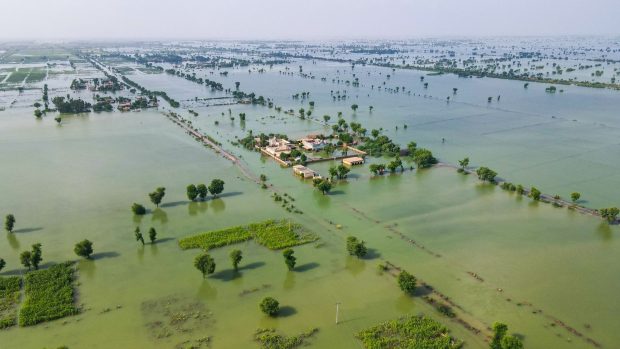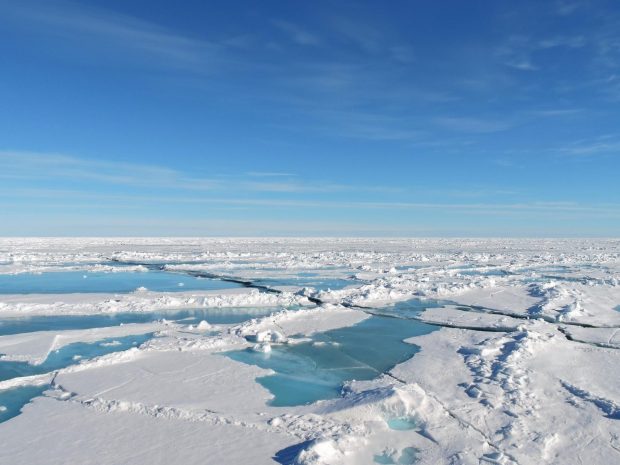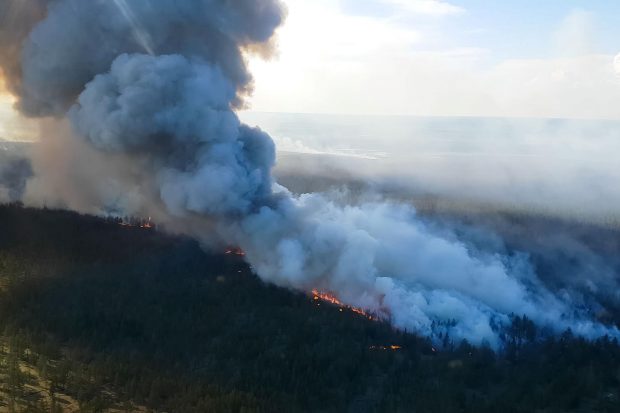
Climate in Asia: Land and ocean warming, rising sea levels, melting glaciers, sea ice loss

GENEVA: The global climate system is complex. In order to help understand such complexity, the WMO State of the Climate reports use climate indicators to describe how the climate has changed—providing a broad view of the climate at a global and regional scale.
These indicators are representative of quantities most relevant to monitoring climate change, including the surface temperature, heat content of the ocean, greenhouse gas concentrations and other factors, as well as the responses of land, oceans and ice.
The following aims to provide an overview of the State of the Climate in Asia in 2022.
THE GLOBAL CONTEXT
Before exploring the state of the climate in Asia, it is important to first know what the overall global climate looked like in 2022.
Atmospheric concentrations of the three major greenhouse gases (CO 2 , CH 4 and N 2 O) reached new observed record highs in 2021 and real-time data indicate that levels continued to increase in 2022.
The global annual mean temperature in 2022 was around 1.15 ±0.13°C above the 1850-1900 pre-industrial average, less warm than in some recent years owing to cooling La Niña conditions at the start and end of the year.
Ocean heat content in 2022 was the highest on record. Ocean warming and accelerated loss of ice mass from the ice sheets contributed to global mean sea level rise, which also reached a record high in 2022.
THE STATE OF THE CLIMATE IN ASIA
Temperature Rise
In 2022, the estimated mean temperature over Asia in 2022 was 0.73°C [0.63–0.78] above the 1991–2020 average, making it either the second or third warmest year on record.
Asia is the continent with the largest land mass extending to the polar region. The warming trends of the continent have exceeded the global mean.
However, temperature rise isn’t happening equally across the continent.
In 2022, above average temperatures were recorded in northern Siberia, the northern Middle East, Central Asia and the western to coastal areas of China.
Precipitation
Precipitation is a key climate parameter, essential for society in terms of providing water for drinking and domestic purposes, agriculture, industry, and hydropower. It also drives major climate events such as droughts and floods.
In 2022, areas with less than normal precipitation included Iraq, the Hindu Kush, the lower course of the Ganges and Brahmaputra Rivers, the Korean Peninsula, and Kyushu, Japan.
Meanwhile, the largest precipitation excesses were observed around the southern half of Pakistan, South-East Asia and north-east China.
Precipitation in much of the region is influenced by El Niño–Southern Oscillation (ENSO).
Watch the video to learn more about how ENSO influences global weather patterns.
Typically, La Niña is associated with above-normal rainfall over South Asia during the summer monsoon season.
India and Pakistan had above-normal rainfall in 2022. Pakistan experienced devastating flooding associated with extreme precipitation in July and August 2022.
Glacial Mass Balance
Glaciers are sensitive to changes in regional temperature, precipitation and surface radiation. As glaciers melt, they can impact global sea level, regional water cycles and local hazard occurrences.
High Mountain Asia is the high-elevation area centered on the Tibetan Plateau, is home to around 100,000 km 2 of glaciers, containing the largest volumes of ice outside of the polar regions.
Over the past 40 years, four glaciers with long-term observations in the High Mountain Asia region experienced mass loss, with an accelerating trend in the 21st century.
For the glaciological year 2021/2022, preliminary data from High Mountain Asia region show continued negative mass changes.
From 2021–2022, Urumqi Glacier No. 1, in the eastern Tien Shan, recorded its second most negative mass balance (‑1.25 m w.e.) since measurements began in 1959.

Arctic Sea Ice
Sea ice extent is another key indicator of climate variability, particularly of changes in polar regions. The presence of sea ice shapes both the regional and global climate.
In the Arctic, the maximum winter sea-ice extent was reached on 21-22 February 2022, two weeks earlier than average, with a value of approximately 15 million km 2 .
Total Arctic sea-ice volume is decreasing. Estimates for 2022 values place the year near the third lowest volume since 2004, following 2020 and 2021.
Ocean Heat Content
Around 90% of the excess energy that accumulates in the earth system due to increasing concentrations of greenhouse gases goes into the ocean, changing its temperature at various levels of depth.
Most of the oceanic area of Asia has recorded increasing ocean heat content in the upper layer of the ocean (0-700m) since 1993.
On average, in 2022, the upper ocean layer in the region recorded its fifth warmest year on record.
Warming is particularly strong in the north-western Arabian Sea, the Philippine Sea and the seas east of Japan, where rates are more than 3x greater than the global mean.
Sea Surface Temperature
Sea surface temperature is another important physical indicator for the Earth’s climate system. Changes in sea surface temperature affect regional and global circulation patterns and critically affect marine ecosystems.
In many areas surrounding Asia, the sea-surface is warming at rates of more than 0.5°C per decade, approximately 3x faster than the global warming rate.
In 2022, the area-averaged SST anomalies were the warmest on record in the north-west Pacific Ocean at more than 0.6°C.
The Barents Sea is identified as a climate change hotspot, with regional warming 5-7 times the global warming average.
It illustrates recent Arctic amplification, the larger warming of the Arctic compared to the rest of the planet.
Sea-surface warming in this area also has a major impact on the observed sea-ice loss – a feedback mechanism which in turn enhances ocean warming.

Sea Level Rise
As the ocean warms and expands and glaciers, ice caps and ice sheets melt, sea levels rise. From 2013-2022, the global average sea level rose at rate of 4.6 mm per year.
However, sea levels are not rising at the same rate everywhere.
Differences in temperature and salinity lead to different levels of rise regionally.
The rates of sea level rise across most of Asia are higher than the global mean rate (GMSL) over 1993–2022 (3.4 ± 0.3 mm per year).
The north-east Indian Ocean and western tropical Pacific region have even higher rates, above 4 mm per year.
EXTREME EVENTS IN ASIA IN 2002
Tropical Cyclones
In 2022, a total of 25 named tropical cyclones, almost the same as the 1991–2020 average.
The strongest TC of the year, Typhoon Nanmadol, made landfall in Japan on 18 September, triggering evacuation orders for approximately four million people, affecting over 1 300, killing 5, and causing more than US$ 2 billion in economic damages.
Typhoon Noru made landfall in Viet Nam on 27 September, induced flooding affected more than 11 000 hectares of rice crops, and killed or swept away about 155 000 cattle and poultry.
Heavy precipitation & flooding
Pakistan received 60% of normal total monsoon rainfall within just three weeks of the start of the 2022 monsoon season, and the heavy rains resulted in urban and flash floods, landslides, and glacial lake outburst floods across the country.
More than 33 million people, almost 14% of the population, were affected; over 1 730 people died and almost eight million people were displaced. In addition to its direct impact on the population, the flooding caused widespread damage to critical infrastructure, houses, and livestock.
In India, flooding caused over 2000 deaths and affected 1.3 million people, the highest number of casualties of any disaster event in 2022 in India.
Flood events were also reported in Afghanistan, leading to approximately 180 deaths and affecting over 18000 people.
Flood events in Southern China were associated with 48 deaths and over US$ 5 billion in economic damages.
The economic losses associated with floods in 2022 exceeded the 2002–2021 average, due to significant economic losses from floods in Pakistan (over US$ 15 billion), China (over US$ 5 billion) and India (over US$ 4.2 billion).
Drought
The Yangtze River Basin is an important water supply used for energy production, transportation, and crop irrigation, and the Three Gorges Dam, the largest hydropower plant in the world. In the summer of 2022, the basin experienced the worst drought in the last six decades, with associated economic losses from the drought estimated at over US$ 7.6 billion.
Between August and September, the Yangtze River flow was about 50% below the average for the previous five years, with significant impacts on energy production and inland shipping.

Heatwaves & Wildfires
India and Pakistan experienced abnormally warm conditions in the pre-monsoon season.
In Japan, the highest temperatures since 1946 were recorded in the western and eastern parts of the country for late June, with 15,000 people hospitalized/treated for heat stroke. In July, the number was over 27,000, the second highest for that month since 2008.
Prolonged dry and hot conditions caused intense and extensive forest fires in Siberia, where approximately 1200 fires had burned about 183,000 hectares.
Marine Heatwaves
Like heatwaves on land, marine heatwaves are prolonged periods of extreme heat that affect the ocean.
In 2022, the most prominent and persistent severe to extreme marine heatwaves occurred in a large area including the Sea of Okhotsk, the Bering Sea and the Pacific area around 60°N of the region and lasted three to five months.
ENHANCING CLIMATE RESILIENCE AND ADAPTATION
IN FOOD SYSTEMS
The need for improved resilience
The agricultural sector continues to bear the brunt of the impacts of disasters. More than 25% of all loss and damage from climate-related disasters such as floods, droughts, and tropical storms is associated with the agriculture sector.
Disasters impact small farmers and rural communities, change agricultural trade flows and cause losses in agriculturally dependent sectors such as the textile industry.
The importance of food system resilience is emphasized in the Nationally Determined Contributions of the parties to the Paris Agreement. Of 31 Asian parties, 26 highlighted agriculture as a top priority for adaptation.
So what can be done?
Impact-based forecasting and anticipatory action
Impact-based forecasting (IBF) involves forecasting “what the weather will do” instead of “what the weather will be.”
Adding socioeconomic layers such as age, gender, income level and exposed assets such as infrastructure to hazard layers such as weather observations, makes it possible to identify potential exposure and vulnerability in advance.
Anticipatory action is an adaptation method which takes IBF to the next level by systematically linking early warnings to early actions carried out before a disaster occurs.
In food system resilience, this includes climate-informed food and land use systems planning, early warnings in advance of weather extremes to advise of potential damage to crops, food shocks, and global transport and trade disruptions.
However, while 77% of WMO Members in Asia provide climate services for agriculture, only 47% reported providing climate projections and tailored products.
There is therefore a need for greater investment in climate and weather services, especially to achieve Early Warning for All .
Overall in 2022, land and ocean warming continued across Asia, contributing to rising sea levels, melting glaciers and sea ice loss.
Above normal rainfall in Pakistan contributed to devastating flooding, whereas drought in China had associated economic losses of approximately US$7.6 billion.
There is an urgent need for improved climate mitigation and adaptation in the region.
Implementing impact-based forecasting and anticipatory action, investing in climate services and ensuring early warnings for all can all help improve resilience.


